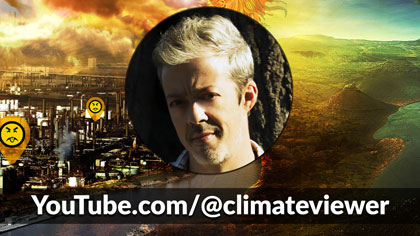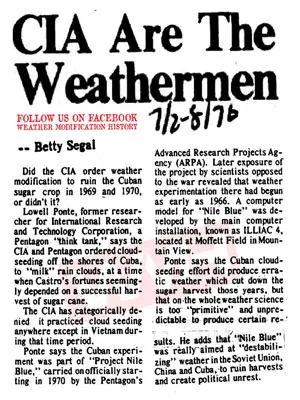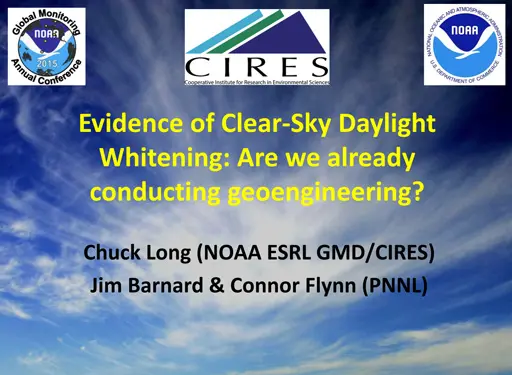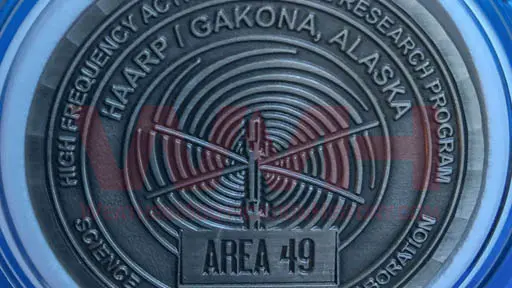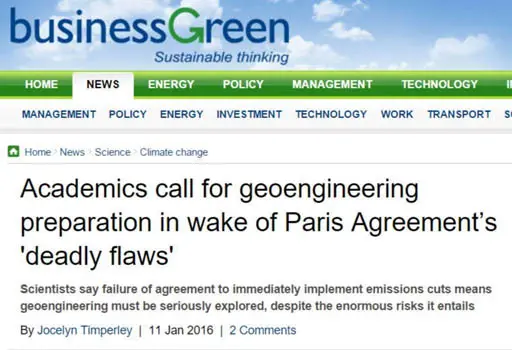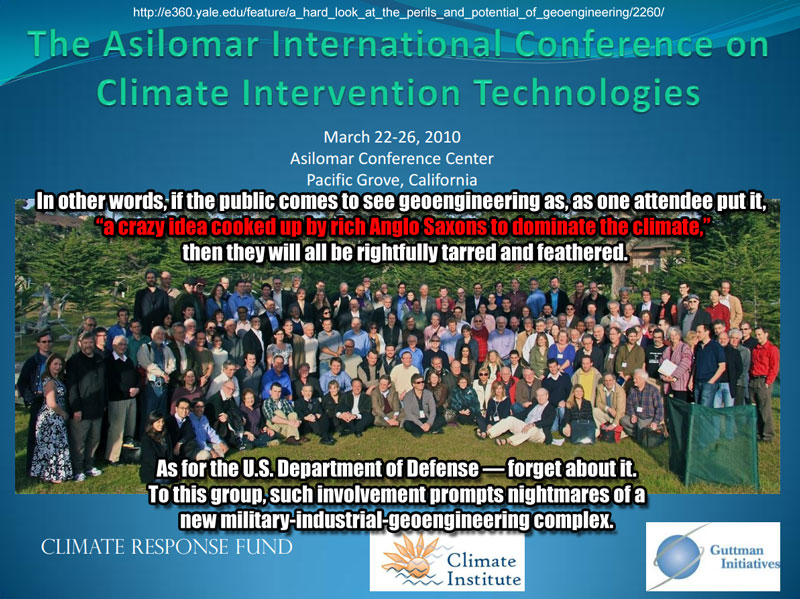
by jeff goodell
In the beginning, I had my doubts. The Asilomar International Conference on Climate Intervention Technologies, held last week at the Asilomar conference grounds near Monterey, Calif., was touted as an “unprecedented” gathering of 175 scientists, environmental groups, philosophers, and public policy wonks to discuss the governance of geoengineering — that is, large-scale, intentional manipulation of the Earth’s climate to offset rising temperatures. The meeting was obviously set up to channel the spirit of the first Asilomar conference in 1975, during which biologists drew up voluntary guidelines to help reassure the public that genetically modified organisms would not be released into the world. Asilomar 1.0 is remembered as a landmark event in the evolution of scientific ethics and a turning point in the public acceptance of biotechnology.
Asilomar 2.0 seemed to pale in comparison. For one thing, geoengineering may be a scary idea, but the dangers were nowhere near as immediate as the unintentional release of genetically modified organisms. As David Keith, head of the Energy and Environmental Systems Group at the University of Calgary and one of the pioneers of geoengineering research, put it, “There is no threat of genetically altered clouds replicating virally in the atmosphere.” For another, no one seemed exactly sure what the goal of Asilomar 2.0 was, other than to convince the rest of the world that geoengineers are not mad scientists bent on destroying whatever is left of the Earth’s “natural” climate system. A few days before the conference began, questions were raised about whether the conference was in fact a quiet way for the organizer of the conference, The Climate Response Fund, to raise money to fund geoengineering experiments (a last-minute statement from the CRF’s board put an end to that controversy).
For a while, it seemed like Asilomar 2.0 was going to devolve into five days of infighting.
The first few days of the conference were chaotic and disorganized, occupied with the familiar discussions about how the term “geoengineering” lumps together two very different ideas about how to cool the planet — technologies that reduce the amount of sunlight that hits the planet, as well as technologies that reduce the amount of carbon dioxide in the atmosphere. From a governance point of view, nobody is worried about technologies that suck CO2 out of the atmosphere. It’s the technologies that reduce the amount of sunlight that hits the planet — such as brightening clouds and injecting sulfur particles in the stratosphere — that freak people out, mostly because they can be deployed quickly and cheaply, and they have an immediate effect.
None of this was news to anyone who had spent any time thinking about geoengineering. And for a while, it seemed like Asilomar 2.0 was going to devolve into five days of infighting over the wisdom of attempting to rebrand geoengineering as “climate restoration.” But then a strange thing happened. Amidst the chaos, new ideas – and some lessons — emerged.
Lesson one: Geoengineering is a tabula rasa in the public mind.
Like most of the attendees, I was well aware of the fact that geoengineering is an unfamiliar idea to many people. But I had not seen any actual data on this. Nor had I really grasped the implications of it.
One of the most enlightening presentations of the week was from Anthony Leiserowitz, director of the Yale Project on Climate Change, who presented the results of a long-running study on the public perception of global warming. In his most recent survey, he had thrown in a few questions about geoengineering. When asked, “How much, if anything, have you heard about geoengineering as a possible response to climate change,” 74 percent of respondents said “nothing.” The 26 percent that had heard about geoengineering turned out to be wildly misinformed — more than half thought it referred to geothermal energy. Only 3 percent of the people who had heard about geoengineering were correctly informed about it. “The public basically knows nothing about this,” Leiserowitz told the attendees. “That is both a great challenge, and a great opportunity.”
Lesson two: Nobody has any clear idea how to resolve the inequalities inherent in geoengineering.
One of the most quoted remarks at the conference came from Pablo Suarez, the associate director of programs with the Red Cross/Red Crescent Climate Centre, who asked during one plenary session, “Who eats the risk?” In Suarez’s view, geoengineering is all about shifting the risk of global warming from rich nations — i.e., those who can afford the technologies to manipulate the climate — to poor nations. Suarez admitted that one way to resolve this might be for rich nations to pay poor nations for the damage caused by, say, shifting precipitation patterns. But that conjured up visions of Bangladeshi farmers suing Chinese geoengineers for ruining their rice crop — a legalistic can of worms that nobody was willing to openly explore.
In one view, geoengineering is about shifting the risk of global warming from rich to poor nations.
There was much discussion about the role the UN Security Council might play in governing the eventual deployment of geoengineering technologies, as well whether a new protocol should be developed to govern geoengineering under the UN Framework Convention on Climate Change. A few people even brought up a new idea: How about a World Geoengineering Council? The concept conjured up visions of black helicopters and Dr. Evil, and was quickly dropped — even though, in private, some policy experts admitted that was the direction we might be headed.
In public, everyone agreed that climate is something that happens to everyone and, therefore, everyone should have a say in any decisions that are made to deliberately change it. But the simple truth is nobody has any very good ideas about how you accomplish that, especially among people in the developing world, where the impact, presumably, would be greatest. Leiserowitz put it best: “What does informed consent mean in a world where more than two billion people are unaware that climate change is a problem?”
Lesson three: The biggest question on the horizon is, “Should field experiments be banned?”
Virtually everyone at the conference agreed that further research into geoengineering is a good idea. “We need to figure out what works and what doesn’t,” David Keith argued. Not surprisingly, conflict arose when the discussion moved on to whether or not it was time to run some field experiments in the real world. Everyone agreed that small-scale “process” experiments, such as testing devices to spray aerosols in the stratosphere, should be allowed, since there is no expectation that such experiments would have any impact on the climate. But what about modest field experiments, such as attempting to spray particles over one region of the Arctic, or brighten clouds over one part of the ocean? Alan Robock, an atmospheric scientist at Rutgers University who has long pointed out the risks of geoengineering field experiments, predictably argued against it: “You can’t wall off the Arctic from the rest of the world.”
Conflict arose when the discussion focused on whether it was time to run field experiments.
But how do you define the difference between “sub-scale” experiments, likely to have little if any impact, with “large” experiments, which could indeed have an impact? This is a perennial problem among prospective geoengineers. Keith argued for the importance of field experiments as a way of testing our knowledge — as well as the accuracy of climate models. “We only found out about the hole in the ozone because we went out and did some experiments,” he argued. “If we would have relied entirely on models, we might never have found it.” In the view of others, it was also a question of urgency: “We don’t want to do modeling for the next 20 years while the Arctic melts,” one scientist told me.
The question of field testing also played into the larger governance issue. David Victor, a law professor at the University of California, San Diego, argued that you can’t set up a workable governance structure until you know which technologies might be deployed and what the risks are. “And to find that out, you might have to do some experiments,” he said.
Lesson four: It’s all about the money. Is anyone going to get rich geoengineering the planet? Nobody likes to ask that question explicitly, but it’s unavoidable. After all, if geoengineering ever gets taken seriously, it’s going to be the mother of all engineering projects. Who should be in charge — and what role should private investment play? Should entrepreneurs be able to profit off technology designed to cool the planet?
Should entrepreneurs be able to profit off technology designed to cool the planet?
It was generally agreed that for CO2-sucking technologies, private investment was not a problem. Sunlight-reduction technologies, however, are another issue. if some company (or entrepreneur) is able to develop a new way of injecting particles into the stratosphere that becomes indispensible to the survival of the human race, well, that gives that company or person a lot of leverage. “I’m not interested in selling my soul to some company who is going to control how much sunlight hits the planet,” said Phil Rasch, a climate modeler at the Pacific Northwest National Laboratory in Washington state. (As one audience member quipped, “Gives new meaning to company town.”) Granger Morgan, the head of the department of engineering and public policy at Carnegie Mellon University, argued that the creation of a profit motive would inevitably lead to a geoengineering lobby: “Lobbying is the last thing we need on this.”
Does that mean government funding, in the U.S. initially through the National Science Foundation or an agency like the National Oceanic and Atmospheric Administration, is the answer? Many attendees pointed out that government funding has its own troubles, not least of which is that the bureaucracy and regulatory hurdles will slow down research and deployment. As for the U.S. Department of Defense — forget about it. To this group, such involvement prompts nightmares of a new military-industrial-geoengineering complex. One novel solution: demand that all technology used for sunlight reduction technologies remain in the public domain. “The issue is not private investment,” argued Keith. “It’s is open intellectual property.” Open-source climate engineering, anyone?
Lesson five: Trust is everything. The media loves to play up the angle of hubristic geoengineers hell-bent on messing with a system they don’t understand, but there was very little bold or reckless talk at Asilomar. The entire mood of the meeting was somber and hyper-alert to the dangers that lay ahead. “The whole game,” David Victor pointed out, “is about establishing credibility.” In other words, if the public comes to see geoengineering as, as one attendee put it, “a crazy idea cooked up by rich Anglo Saxons to dominate the climate,” then they will all be rightfully tarred and feathered.
In the end, I didn’t leave Asilomar feeling like I’d attended a historic event. But I did feel like I may have witnessed the birth of something new — call it the conscience of a geoengineer.




